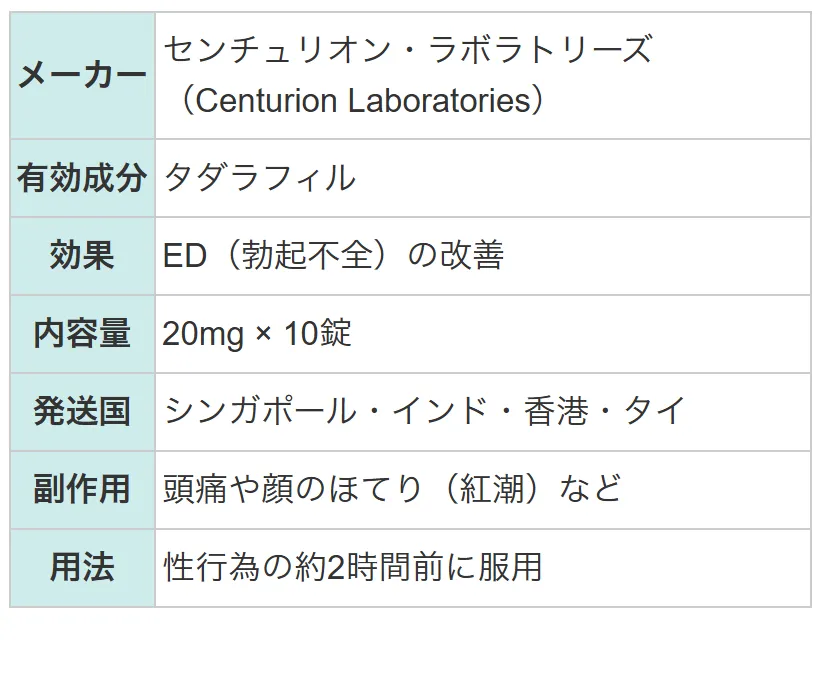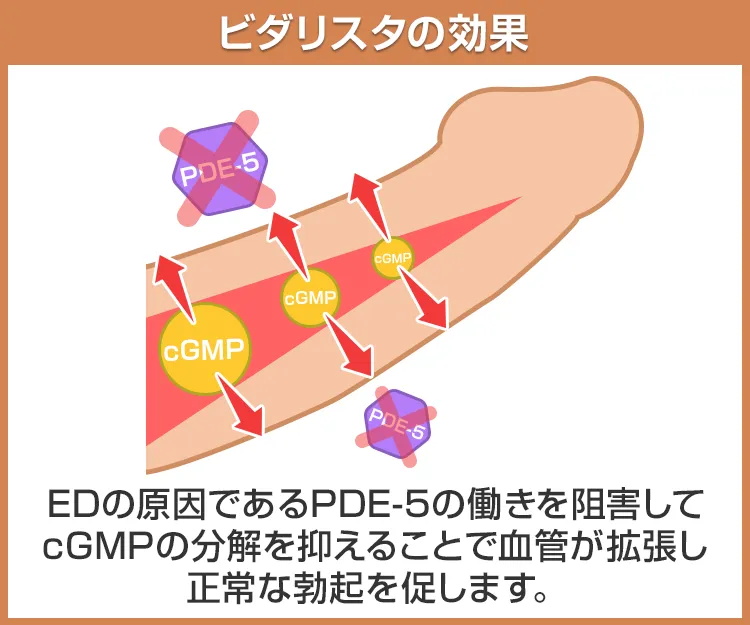絶賛4股中です。以前は、立て続けてのデートで勃たずに困ることも多かったんですけど、ビダリスタと出会えてからデート前に仕込んでおけば、デートが続いても勃たなくなるなんてことがなくなったので、まじで助かってます(笑)

左記クレジットカード、銀行振込、コンビニ決済に対応







更新日:2025/6/18
ビダリスタは、長時間作用するED治療薬シアリスのジェネリック医薬品です。
1錠あたりの価格はシアリスの約1/16であり、コストパフォーマンスが高いという特徴があります。
| メーカー | センチュリオン・ラボラトリーズ(Centurion Laboratories) |
|---|---|
| 有効成分 | タダラフィル |
| 効果 | ED(勃起不全)の改善 |
| 副作用 | 頭痛や顔のほてり(紅潮)など |
| 用法 | 性行為の約2時間前に服用 |
ビダリスタの有効成分タダラフィルには、勃起時にペニスの血管収縮を促してEDを発症させるPDE-5(ホスホジエステラーゼ5)を阻害する作用があります。勃起時の血管拡張・血流増量がスムーズになるため、正常な勃起が可能となります。
ビダリスタには、1錠あたり20mgのタダラフィルが含有されています。

| 個数 | 販売価格(1錠あたり) | 販売価格(箱) | ポイント | 購入 |
|---|---|---|---|---|
| 10錠 | 216円 | 2,160円 | 64pt | |
| 50錠 | 205円 | 10,260円 | 307pt | |
| 100錠 | 194円 | 19,440円 | 583pt |






①1万円以上で送料無料
1回の注文で10,000円以上だった場合、1,000円の送料が無料となります。
まとめ買いをすると1商品あたりのコストパフォーマンスが高くなるためおすすめです。
②プライバシー守る安心梱包
外箱に当サイト名や商品名が記載されることはないため、ご家族や配達員など第三者に内容を知られることは御座いません。

③100%メーカー正規品取り扱い
当サイトの商品は100%メーカー正規品となっており、第三者機関による鑑定も行っております。
商品の破損などがあった場合は再配送などにて対応させて頂きますので、ご連絡頂ければ幸いです。

④いつでも購入可能 処方箋不要
サイト上では24時間いつでもご注文を受けております。
また、お電話によるご注文も受け付けておりますのでネットが苦手な方はお気軽にどうぞ。

⑤商品到着100%
商品発送後はお荷物の追跡状況が分かる追跡番号をご案内させて頂きます。
郵便局には保管期限がありますのでご注意ください。
・自宅配達で不在だった場合の保管期限・・・16日間前後
・郵便局留めとした場合の保管期限・・・7~30日間

⑥コンビニ決済利用可能
ご近所のコンビニにていつでもお支払可能です。
セブンイレブンに限り店舗での機械操作を必要とせず、手続き完了後に表示されるバーコードや払込票番号をレジに提示することでお支払い頂けます。

ビダリスタ 20mg x 10錠
2,160円
ポイント:64pt
10,000円以上購入で送料無料
在庫あり

| 商品名 | シアリス | バイアグラ | レビトラ |
|---|---|---|---|
| 効果時間 | 12~36時間 | 4~5時間 | 5~10時間 |
| 発現時間 | 60分 | 30~60分 | 15~30分 |
| 副作用 | 非常に少ない | 少ない | 少ない |
絶賛4股中です。以前は、立て続けてのデートで勃たずに困ることも多かったんですけど、ビダリスタと出会えてからデート前に仕込んでおけば、デートが続いても勃たなくなるなんてことがなくなったので、まじで助かってます(笑)
行為の約3時間も前に飲まないと書いてたからそれだけでも長いと思ってたけど、それ以上になかなか効かなくてビビった・・・。飲んでもなかなかたたず雰囲気も崩れたので結局ヤレませんでした。
しっかりと密閉した状態であれば夏季なら1週間ほど、冬季なら2週間ほどが目安となります。それ以上の期間が経過している場合やいつカットしたか分からないような錠剤は服用せずに廃棄してください。
体質的に効きにくいという方も稀にいらっしゃいますが、効かない場合は飲み方に問題がある場合が多いです。ビダリスタは食事の影響を受けにくいですが、食事前後に服用したり、大量に飲酒した場合は十分な効果を発揮することができない場合があります。用法用量に従って服用してみることを推奨します。
シアリスやシアリスジェネリックの最大効果時間は36時間です。もし、服用から4~5日経過しても効果が続いているように感じている場合は病院へ相談に行くことを推奨します。
シアリスもシアリスジェネリックも成分は同じなのでどちらが良い・悪いというような優劣は付けられません。しかし、ジェネリック医薬品は安価で購入することが出来るため、コスパを重視される方はジェネリック医薬品を好まれる傾向にあります。
個人差はありますが服用から1時間ほどで効果を実感できます。また、効果のピークは1~4時間後になります。
感じ方については個人差があり、一概にシアリスが弱いとは断言できません。シアリスの効果は他2剤と比べると「マイルド」といった声は多くありますが、その一方で「シアリスが一番効く」という声もあります。どのED治療薬が自分に一番合っているのかを知るために飲み比べてみてはいかがでしょうか。
ビダリスタに精液量を増やす直接的な効果はありません。精液を増やしたい場合はバランスの良い食事を取ったり、ストレスを溜めすぎない、適度な運動を行うなど健康的な生活を送るように心がけてみましょう。
大変危険ですので絶対にやめてください。ビダリスタとバイアグラに限った話ではなく2種類のED治療薬を同時に服用することは厳禁です。ED治療薬は1錠でも血管を拡張する作用が強く働くため、過剰に摂取すると低血圧などの副作用が引き起こされやすくなります。また、2種類を服用したからといって相乗効果が得られるわけでもありません。
問題ありません。ビダリスタは空腹時の服用が推奨されていますが、頭痛薬のような消炎鎮痛剤は空腹時に服用すると胃が荒れやすくなってしまいます。そのため、胃の痛みや不快感が気になる方は更に胃薬も服用すると良いでしょう。
必ずしもそうとは限りませんが、確かに体格の大きな人には推奨されている用量よりも多く処方される場合があります。しかし、ご自身で試される場合はまずは低用量のものから開始し、効果を実感できなかった場合にのみ増量することを推奨いたします。
| 1日の服用回数 | 1回 |
|---|---|
| 1回の服用量 | 10~20mg |
| 服用のタイミング | 性行為の約2時間前 |
| 服用間隔 | 24時間 |
| 商品名 | シアリス | タスティリア | パルモプレス | アフィルタ | シルデナフィル(TEVA) | タダライズオーラルゼリー | タドリス | タダラフィル | タダリフト |
|---|---|---|---|---|---|---|---|---|---|
| 商品画像 |  |  |  |  |  |  |  |  |  |
| 特徴1 | 最長36時間に渡って効果が持続する | 口の中で溶かすODフィルムタイプ | ・シアリスジェネリックの中でも低価格 | ・血管を拡張させて勃起をサポート | ・バイアグラと変わらない効き目を発揮 | 水なしでも簡単に飲めるゼリータイプ | 水に溶かして飲む発泡錠タイプ | 有名メーカーが手がけたジェネリック | ・効果時間が24時間から36時間と非常に長い |
| 特徴2 | マイルドに効くので自然に近い勃起に! | 10mg、20mgの2種類から選べる | ・持続時間が長く、36時間も効果が持続 | ・服用後36時間まで効果が持続 | ・安全性が高いと証明されている成分を配合 | 食事のついでに飲めて使い勝手が良い | 錠剤の嚥下が難しい方におすすめ | 先発薬シアリスより安価に購入できる | ・ジェネリック医薬品のため安価で購入できる |
| 内容量 | 20mgx4錠 | 20mgx10枚 | 20mgx15錠 | 20mg4錠x1箱 | 50mg4錠x1箱 | 20mgx10袋 | 20mgx4錠 | 5mg28錠x1箱 | 20mgx4錠 |
| 価格 | 12,100円 | 2,520円 | 4,050円 | 4,360円 | 3,500円 | 2,250円 | 2,380円 | 5,360円 | 2,000円 |
| 1%以上 | 0.2〜1%未満 | 0.2%未満 | 頻度不明 | |
| 循環器 | 潮紅 | 動悸、ほてり | 血管拡張、心拍数増加、胸痛、狭心症、頻脈、高血圧、低血圧 | 心筋梗塞、心臓突然死、失神、起立性低血圧 |
| 感覚器 | 霧視、眼の充血、眼の異常感 | 耳鳴、視覚障害、眼痛、流涙増加、眼刺激、結膜充血、視野欠損、結膜炎、乾性角結膜炎、眼瞼腫脹 | 色覚変化、回転性眩暈、網膜静脈閉塞、非動脈炎性前部虚血性視神経症、網膜動脈閉塞、中心性漿液性脈絡網膜症 | |
| 消化器 | 消化不良 | 上腹部痛、悪心、胃食道逆流性疾患、下痢、口内乾燥、胃炎、嘔吐、腹痛、胃(胸部)不快感 | 便秘、腹部膨満、軟便、胃刺激症状、嚥下障害 | 食道炎 |
| 肝臓 | 肝機能異常(AST上昇、ALT上昇、γ-GTP上昇を含む) | ALP上昇 | ||
| 腎臓 | 腎機能障害、尿酸値上昇 | |||
| 筋骨格 | 背部痛、筋痛、四肢痛 | 関節痛、筋痙攣(筋収縮)、筋骨格痛 | 筋骨格硬直、頚部痛、殿部痛 | |
| 精神・神経系 | 頭痛 | めまい、睡眠障害 | 錯感覚、傾眠、不安、片頭痛 | 脳卒中、感覚鈍麻 |
| 泌尿・生殖器 | 排尿困難、勃起増強、意図しない勃起 | 持続勃起症、勃起の延長 | ||
| 呼吸器 | 鼻閉 | 鼻炎、副鼻腔うっ血 | 呼吸困難、喀血 | 鼻出血、咽頭炎 |
| 皮膚 | 紅斑、多汗、爪囲炎 | そう痒症 | ||
| その他 | 疲労、無力症、疼痛、体重増加、倦怠感 | 熱感、末梢性浮腫、粘膜浮腫、口渇 |
本製品は海外製のため、期限表記が日本と異なる場合がございます。
パッケージ裏面や側面、シートなどに以下のような表記がされています。
| EXP | 使用期限 例:EXP 12/2025→2025年12月まで使用可 |
|---|---|
| MFG または MFD | 製造日 例:MFG 03/2023 |
| BEST BEFORE | 品質が最も安定している目安日 |


※国や製品により日付の並び(例:月/年、日/月/年)が異なる場合がありますのでご注意ください
EXP(Expiry Date) の表記がなく、MFG または MFDしか記載がないケースがあります。
この場合は MFG(MFD) から2~3年が使用期限の目安です。
※「LOT」や「BATCH」の表記は製造番号であり期限ではありません。

パッケージ例となります。
商品やご注文単位によってはシート単位でのお届けとなる場合が御座います。
外箱に当サイト名や商品名が記載されることはないため、ご家族や配達員など第三者に内容を知られることは御座いません。
絶賛4股中です。以前は、立て続けてのデートで勃たずに困ることも多かったんですけど、ビダリスタと出会えてからデート前に仕込んでおけば、デートが続いても勃たなくなるなんてことがなくなったので、まじで助かってます(笑)
ここ数か月使わせてもらってます。効果が長く続くことにおいては最強だと思います。ただ、もうちょっと硬さの方も強く出てくれれば最高だったな~っていう感想ですね。
24時間戦えますか?そんなCMソングを思いだすほどの、長時間効果を実感できています。普段バイアグラを使ってますが、これなら飲むタイミングを気にせずに使えるのがかなり良いなと思いましたし、効果も十分で大満足です。
ちゃんと効いてくれた。しかも、前よりも硬いような気がする。副作用はあるけど、自分的には許容範囲内かな。
リピートしまくり。ご飯食べた後でも効いてくれるから助かる。効き目は長いから、彼女の家に泊まりに行っても、朝から夜まで楽しめちゃう♪
商品口コミの投稿は会員のみ行えるようになっております。
お手数ですが会員ログインの上でご投稿頂きますようお願いいたします。
口コミをご投稿頂いたお客様にはポイントをプレゼントさせて頂いております。
文章のみであれば100ポイント、文章+写真付きのものは300ポイントをプレゼントさせて頂きます。
規約や詳細などはこちらをご確認くださいませ。